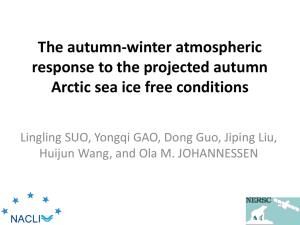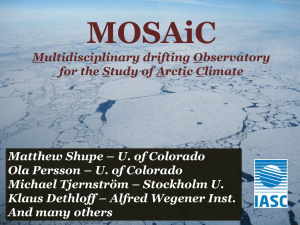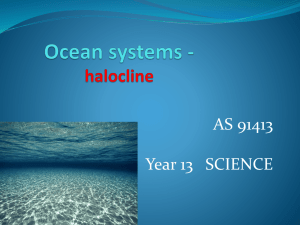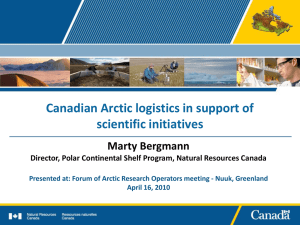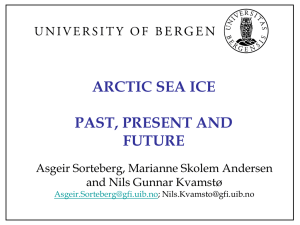PTC 2012 Presentation - Pacific Telecommunications Council
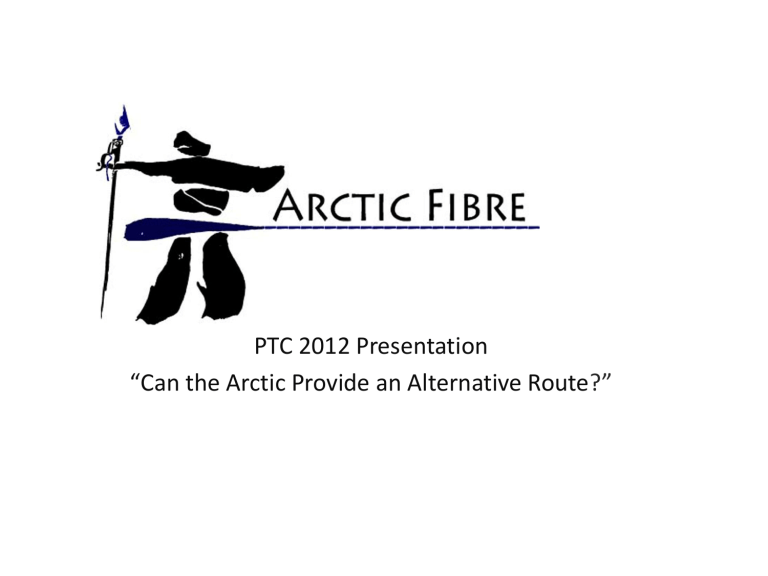
PTC 2012 Presentation
“Can the Arctic Provide an Alternative Route ?”
Why? Iqaluit had no Bandwidth October 6, 2012
2
Why? The Rationale For Arctic Routings
• Creates physically diverse 15,686 km. route from Japanese/Korean/Northern Chinese markets to Europe avoiding problematic Luzon Strait, South China Sea, Suez Canal and
Mediterranean subsea issues.
• Reduces physical routing risk from earthquakes in Western Pacific and Mediterranean as well as cable cuts or political unrest in the Suez Canal region.
• Eliminates need for transAmerica or transSiberia terrestrial crossings and political/security risk concerns of Asian and Middle Eastern carriers at U.S. Cable landing stations
• Provides lowest latency route from Shanghai, South Korea and Japan to London 168 (ms) coveted by financial services clients and video-intensive services.
• Bridges the digital divide between Alaskan and Canadian Arctic communities and the south by displacing temperamental satellite feeds north of 64 degrees north.
• Provides virtually unlimited bandwidth for Alaskan and Canadian communities to address intra-regional needs thereby reducing the cost of providing health care, education and administration of justice.
• Provides essential, reliable connectivity for the proposed Canadian High Arctic Research
Service and Canadian Armed Forces at Cambridge Bay.
3
Where? Tokyo to NYC & London
4
When? Past Arctic Telecommunications Efforts
• Original BT “Project Snowboard” subsea fibre proposals dating back to early 1980s were abandoned due to proliferation of transAtlantic and transPacific crossings.”
• The Alaskan-based ArcticLink $1,200 million project through the far North West
Passage was promoted on the basis of U.S. Broadband stimulus funding ($350 million) which never materialized.
• The Polarnet Project is proposing a $860 million Russian-financed system
(RUTACS) from Bude, UK through Murmansk, north across the Siberian Sea through the Bering Strait south into Vladivostok and south into Tokyo.
• Arctic Fibre is a $640 million Canadian-led initiative through the southern
Canadian portion of the Northwest Passage to achieve economies of scale by providing bulk bandwidth between Northern Europe and Japan with the need to provide primary bandwidth to citizens in remote Arctic communities and to the
Canadian Government.
• Any northern project requires profitable domestic demand or government subsidy because international commodity pricing across the transAtlantic-US-transAtlantic routes cannot support capital expenditure
5
When? As Mother Nature permits!
6
When? Lay Cable When the Sun Still Shines!
• Along most of the Northwest Passage (southern route) route, the sun shines 24/7 from early June to late July. The ice now melts long enough for Arctic Fibre to have an ice-free window from August 20 th until October 5 th either side of the Boothia
Peninsula.
• Global warming has shrunk polar ice cap to point by 40% from 1968-2010.
• Ice thickness in Arctic Fibre’s marine routing reaches maximum 2.6m thickness vs.
3.2m in 1971.
• ArcticLink routing through northern portion of the Northwest Passage crosses permanent polar ice cap and would require icebreakers.
• Siberian ice now melts sufficiently to enable Polarnet Project installation: concerns exist about ice ridge damage to cable in shallow Siberian waters.
• In 2003 Tyco built SSOTS 2,800 km from Norway to Svalbard Islands (78 N) without incident or subsequent technical issues.
• In 2009 Tele-Greenland constructed Newfoundland-Greenland segment to Nuuk
(64N). No issues in “Iceberg Alley” but iceberg incident within Nuuk, Greenland harbour being rectified with horizontal drilling.
• Offshore pipelines buried off Alaska North Slope for decades without incident.
7
When? Phase One RFS November 2013
8
When? Entire network RFS November 2014
9
How? Overengineer for Highest Risk
10
How? Arctic Challenges and Risk Mitigation
Challenge Scope Risk Mitigation
Icebergs
Bergy Bits
Ridge Ice Scouring Ice ridges to 18 m deep, scour depth 1.2m
(bummocks)
Ice Covering
(seasonal)
CLS Approaches
Greenland icebergs 80-170m deep
Smaller icebergs (depth to 20M) can scour seabed to 1.0-1.5 m
Routing is 600-3500 m deep in Davis Strait
Ice Scour study integral part of marine survey
Burial to 3m where required
Deepwater approach to Milton CLS
Satellite monitoring of bergs
Choose deepest routing > 50m depth
Burial in all prone waters <40m depth
Avoid nearshore ridges, shoulders
Double-armored fibre in ice-prone waters
Rock armour where appropriate
Select deepest routing > 50m depth
Burial in all prone waters <40m depth
Choose wind-protected shore approaches
Rock armour where appropriate
Approx 37% route ice-covered >5 months Enlist icebreaker support with ROV capability
Utilize Canadian Ice Survey, C-CORE data
Minimize ice-covered route
Landing at Cambridge Bay CLS
Approaches at Taloyoak, Boothia Ithmus
Choose deepest routing > 50m depth
Horozontal drilling to 40 m
Duplicate, disparate shore approaches
11
How? Risk Mitigation continued
Remote Spur Breaks
Electrical Supply
Amplifier Failure
Between 11-14 Arctic community spurs Utilize deepwater Bus and spurs
Distinct fibre pair from express routes
Horozontal drilling to 40 m depth
No service to vulnerable communities
Lacklustre, spikey supply in remote hamlets End feed from Tokyo, Cambridge Bay, Bude
DND multiple backups at Cambridge Bay
Insulate festoon system from express
34 %subsea plant inaccesible 7 months p.a.
Ensure amplifer spacing is adequate
Minimize spur amplifiers
Maintenance Interval
Other Physical Threats
34 %subsea plant inaccesible 7 months p.a.
Trawling
Anchorages
Seismic
Pipelines
Employ flexible OADM design
Utilize proven technology
Over design and over build
Join Pacific and Atlantic mtce associations
Enlist icebreaker support with ROV capability
Adapt local shallow-hulled vessel for repairs
Little trawling in ice prone Arctic
Proactive charting and communications
Establish "No Anchor" zones
Proactive Canadian Coast Guard program
Install BU offshore Japan for China link
Take wider SE approach to Japan fault zone
Few seismic issues in Arctic
Avoidance or burial where appropriate
Learn from Beaufort experience
12
What? Network Design and Connectivity
• Three intercontinental pairs with 80 wavelengths at 40 Gbps = 9.6 terabits total capacity, upgradeable to 100G. Additional festoon pair with similar capacity 80x40Gbps=3.2 terabits.
• AFI-1 and AFI-2 are two express fibre pairs from Tokyo-London without terrestrial landings with
AF-3 being express pair between Tokyo and Newfoundland (with onward connection to New York
City).
• AFI-4 (in the same cable sheath) will be festoon system with spurs to:
Alaska – Gambell, Nome, Point Hope, Wainwright, Barrow, Prud
Canada–Tuktoyaktuk, Cambridge Bay, Goja Haven, Taloyoak, Igloolik, Hall Beach,
Cape Dorset, Iqaluit
• Arctic spurs segregated electronically and electrically so express backbone survives any nearshore incidents. Duplicate, but geographically-separate landing approaches at Cambridge Bay and
Taloyoak dramatically reduce prospect of backbone network failure.
• Cable landing points in Bude, United Kingdom and Chikura, Japan facilitate access to other international and domestic networks in Europe and North Asia.
• Offshore BU stub SE of Japan will eventually connect to Chongming (Shanghai) and reduce seismic risk.
• Eventual mesh ring connected through Tuktoyaktuk, NWT and Prudhoe Bay, Alaska will provide terrestrial links to North American networks.
13
Who? Corporate Structure and Governance
• Arctic Fibre Inc. is incorporated within Province of Ontario, Canada to hold assets within
Canada and its territorial waters to comply with Telecommunications Act foreign ownership restrictions.
• International segments will be owned by Bermudian or Barbados company to facilitate low-tax treatment.
• Hybrid ownership consisting of Canadian financial institutions, pension funds, territorial development corporations and management. International carriers permitted to own IRUs or minority equity interest.
Current Board includes:
Chairman – The Hon. James Farley QC, Counsel to McCarthy Tetrault, has extensive telecommunications experience both as an investor to fibre projects and as a bankruptcy court judge.
President – Douglas Cunningham, has 40 years telecom investment experience and has launched or financed such projects as TeleBermuda, GlobeNet Communications, Antilles
Crossing, TeleBarbados and TeleCayman and North Atlantic Fibre.
Director – Jim Meenan, is a former President of AT&T Canada, CFO of AT&T Long
Distance and until recently was a Director of 360 networks.
14
3 Otter Crescent,
Toronto, ON, Canada
M5N 2W1
416-613-6263 doug@arcticfibre.com
15


